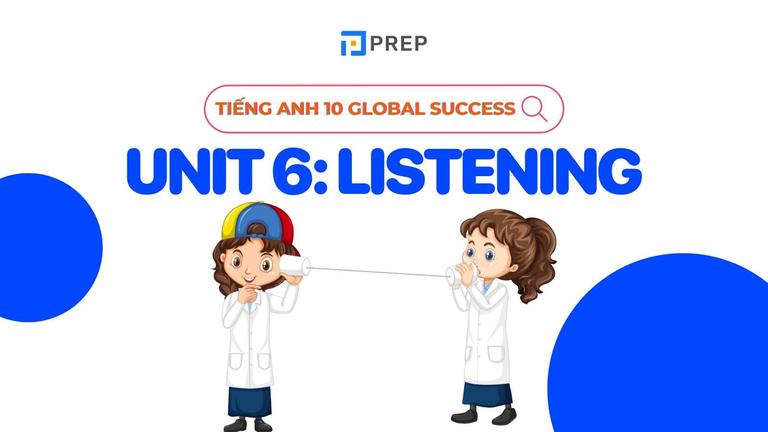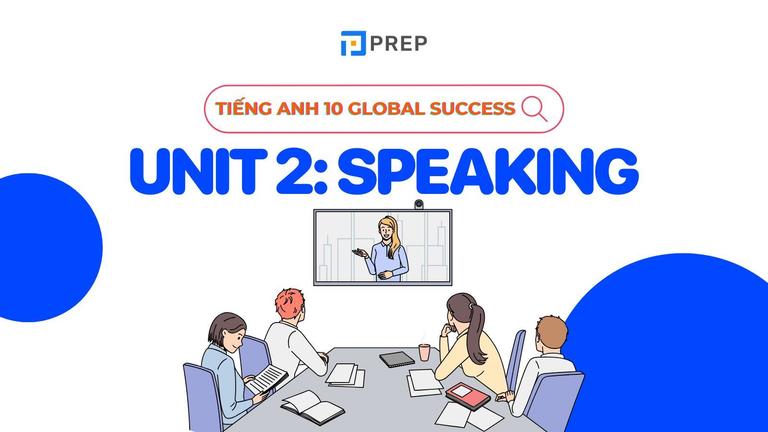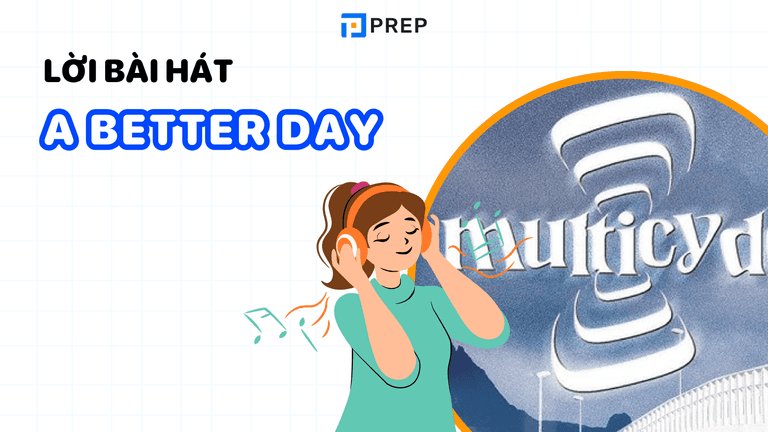Giải đề chi tiết Cambridge IELTS 16 Test 2 Reading Passage 2: I Contains Multitudes
Cambridge IELTS 16 Test 2 Reading Passage 2: I Contains Multitudes là một bài đọc thú vị về thế giới vi sinh vật và mối quan hệ phức tạp giữa chúng với con người. Bài đọc này thuộc dạng Academic Reading với độ khó trung bình, yêu cầu thí sinh có kỹ năng đọc hiểu tốt và khả năng paraphrase linh hoạt. Dưới đây là phần giải chi tiết dạng bài này kèm những lưu ý quan trọng khi làm bài mà Prep chia sẻ đến bạn.

I. Đề Cambridge IELTS 16 Tets 2 Reading Passage 2
Đề bài Cambridge IELTS 16 Tets 2 Reading Passage 2:
I contain multitudes
Wendy Moore reviews Ed Yong s book about microbes
Microbes, most of them bacteria, have populated this planet since long before animal life developed and they will outlive us. Invisible to the naked eye, they are ubiquitous. They inhabit the soil, air, rocks and water and are present within every form of life, from seaweed and coral to dogs and humans. And, as Yong explains in his utterly absorbing and hugely important book, we mess with them at our peril.
Every species has its own colony of microbes, called a ‘microbiome’, and these microbes vary not only between species but also between individuals and within different parts of each individual. What is amazing is that while the number of human cells in the average person is about 30 trillion, the number of microbial ones is higher- about 39 trillion. At best, Yong informs us, we are only 50 per cent human. Indeed, some scientists even suggest we should think of each species and its microbes as a single unit, dubbed a ‘holobiont’.
In each human there are microbes that live only in the stomach, the mouth or the armpit and by and large they do so peacefully. So ‘bad’ microbes are just microbes out of context. Microbes that sit contentedly in the human gut (where there are more microbes than there are stars in the galaxy) can become deadly if they find their way into the bloodstream. These communities are constantly changing too. The right hand shares just one sixth of its microbes with the left hand. And, of course, we are surrounded by microbes. Every time we eat, we swallow a million microbes in each gram of food; we are continually swapping microbes with other humans, pets and the world at large.
It’s a fascinating topic and Yong, a young British science journalist, is an extraordinarily adept guide. Writing with lightness and panache, he has a knack of explaining complex science in terms that are both easy to understand and totally enthralling. Yong is on a mission. Leading us gently by the hand, he takes us into the world of microbes- a bizarre, alien planet – in a bid to persuade us to love them as much as he does. By the end, we do.
For most of human history we had no idea that microbes existed. The first man to see these extraordinarily potent creatures was a Dutch lens-maker called Antony van Leeuwenhoek in the 1670s. Using microscopes of his own design that could magnify up to 270 times, he examined a drop of water from a nearby lake and found it teeming with tiny creatures he called ‘animalcules’. It wasn’t until nearly two hundred years later that the research of French biologist Louis Pasteur indicated that some microbes caused disease. It was Pasteur’s ‘germ theory’ that gave bacteria the poor image that endures today.
Yong’s book is in many ways a plea for microbial tolerance, pointing out that while fewer than one hundred species of bacteria bring disease, many thousands more play a vital role in maintaining our health. The book also acknowledges that our attitude towards bacteria is not a simple one. We tend to see the dangers posed by bacteria, yet at the same time we are sold yoghurts and drinks that supposedly nurture ‘friendly’ bacteria. In reality, says Yong, bacteria should not be viewed as either friends or foes, villains or heroes. Instead we should realise we have a symbiotic relationship, that can be mutually beneficial or mutually destructive.
What then do these millions of organisms do? The answer is pretty much everything. New research is now unravelling the ways in which bacteria aid digestion, regulate our immune systems, eliminate toxins, produce vitamins, affect our behaviour and even combat obesity. ‘They actually help us become who we are,’ says Yong. But we are facing a growing problem. Our obsession with hygiene, our overuse of antibiotics and our unhealthy, low-fibre diets are disrupting the bacterial balance and may be responsible for soaring rates of allergies and immune problems, such as inflammatory bowel disease (IBD).
The most recent research actually turns accepted norms upside down. For example, there are studies indicating that the excessive use of household detergents and antibacterial products actually destroys the microbes that normally keep the more dangerous germs at bay. Other studies show that keeping a dog as a pet gives children early exposure to a diverse range of bacteria, which may help protect them against allergies later.
The readers of Yong’s book must be prepared for a decidedly unglamorous world. Among the less appealing case studies is one about a fungus that is wiping out entire populations of frogs and that can be halted by a rare microbial bacterium. Another is about squid that carry luminescent bacteria that protect them against predators. However, if you can overcome your distaste for some of the investigations, the reasons for Yong’s enthusiasm become clear. The microbial world is a place of wonder. Already, in an attempt to stop mosquitoes spreading dengue fever- a disease that infects 400 million people a year- mosquitoes are being loaded with a bacterium to block the disease. In the future, our ability to manipulate microbes means we could construct buildings with useful microbes built into their walls to fight off infections. Just imagine a neonatal hospital ward coated in a specially mixed cocktail of microbes so that babies get the best start in life.

Xem thêm: Review sách Cambridge 16 chi tiết & cách luyện đề hiệu quả
II. Đáp Án Đầy Đủ Cambridge IELTS 16 Test 2 Reading Passage 2
|
Câu hỏi |
Đáp án |
Loại câu hỏi |
|
14 |
D |
Matching headings |
|
15 |
C |
Matching headings |
|
16 |
A |
Matching headings |
|
17 |
G |
Matching headings |
|
18 |
B |
Matching information |
|
19 |
H |
Matching information |
|
20 |
E |
Matching information |
|
21 |
Yes |
Yes/No/Not Given |
|
22 |
No |
Yes/No/Not Given |
|
23 |
Not Given |
Yes/No/Not Given |
|
24 |
Yes |
Yes/No/Not Given |
|
25 |
Not Given |
Yes/No/Not Given |
|
26 |
No |
Yes/No/Not Given |
III. Giải thích chi tiết đáp án
Questions 14-17: Matching Headings
Mẹo làm bài: Đọc các heading trước, sau đó đọc câu đầu và câu cuối của mỗi đoạn để xác định ý chính.
Question 14: Đáp án D
-
Vị trí: Đoạn 1, câu đầu tiên
-
Từ khóa then chót: "exist longer" ↔ "outlive"
-
Giải thích: Đoạn 1 nói về việc vi sinh vật đã tồn tại từ lâu trước khi động vật xuất hiện và sẽ tồn tại lâu hơn chúng ta
Question 15: Đáp án C
-
Vị trí: Đoạn 2, câu thứ 2
-
Từ khóa then chót: "impressed" ↔ "amazing"
-
Giải thích: Thông tin về số lượng tế bào vi sinh vật (39 nghìn tỷ) nhiều hơn tế bào người (30 nghìn tỷ)
Question 16: Đáp án A
-
Vị trí: Đoạn 5
-
Giải thích: Đoạn này mô tả khám phá của Antony van Leeuwenhoek về vi sinh vật vào những năm 1670
Question 17: Đáp án G
-
Vị trí: Đoạn 6, câu đầu tiên
-
Từ khóa then chót: "illness" ↔ "disease"
-
Giải thích: Nói về vai trò tích cực của vi sinh vật trong việc duy trì sức khỏe
Questions 18-20: Matching Information
Chiến lược: Xác định từ khóa trong câu hỏi, sau đó scan toàn bài để tìm thông tin tương ứng.
Question 18: Đáp án B
-
Vị trí: Đoạn 6, ba câu cuối
-
Paraphrase quan trọng: "partnership" ↔ "symbiotic relationship"
-
Nội dung: Mối quan hệ cộng sinh giữa con người và vi khuẩn
Question 19: Đáp án H
-
Vị trí: Đoạn 7, câu cuối
-
Paraphrase quan trọng: "upsetting" ↔ "disrupting", "nutrition" ↔ "diet"
-
Nội dung: Chế độ ăn không lành mạnh phá vỡ cân bằng vi khuẩn
Question 20: Đáp án E
-
Vị trí: Đoạn 7, câu cuối
-
Paraphrase quan trọng: "excessive focus" ↔ "obsession", "cleanliness" ↔ "hygiene"
-
Nội dung: Việc ám ảnh về sự sạch sẽ gây hại cho cân bằng vi khuẩn
Questions 21-26: Yes/No/Not Given
Lưu ý quan trọng:
-
Yes: Thông tin trong bài hoàn toàn phù hợp với câu hỏi
-
No: Thông tin trong bài trái ngược với câu hỏi
-
Not Given: Không có thông tin liên quan trong bài
Question 21: Yes
-
Giải thích: Bài đọc xác nhận rằng việc sử dụng quá nhiều sản phẩm kháng khuẩn có thể tiêu diệt vi khuẩn có lợi
Question 22: No
-
Giải thích: Bài đọc cho rằng việc nuôi chó giúp trẻ tiếp xúc với nhiều vi khuẩn, điều này có lợi cho sức khỏe
Question 23: Not Given
-
Giải thích: Không có thông tin về việc sách có quá nhiều nghiên cứu hay không
Question 24: Yes
-
Giải thích: Bài đọc đề cập đến các nghiên cứu "less appealing" bao gồm nghiên cứu về mực
Question 25: Not Given
-
Giải thích: Chỉ đề cập đến việc ngăn chặn dịch bệnh thành công, không nói có bất ngờ hay không
Question 26: No
-
Giải thích: Bài nói về kế hoạch tương lai, chưa thực hiện ở bệnh viện nào
IV. Từ vựng quan trọng cần nhớ trong bài
Từ vựng
-
Microbes/Microorganisms: Vi sinh vật
-
Symbiotic relationship: Mối quan hệ cộng sinh
-
Bacterial balance: Cân bằng vi khuẩn
-
Antibacterial products: Sản phẩm kháng khuẩn
-
Pathogenic: Gây bệnh
Paraphrase Patterns Quan Trọng
-
exist longer = outlive
-
impressed = amazing
-
partnership = symbiotic relationship
-
upsetting = disrupting
-
excessive focus = obsession

V. Một số lỗi thường gặp khi xử lý các dạng bài Reading
Dưới đây là một số lỗi thường gặp khi xử lý các dạng bài Reading bạn nên lưu ý:
1. Matching Headings
-
Chọn heading dựa trên 1-2 từ khóa mà không hiểu ý chính đoạn
-
Không phân biệt được main idea và supporting details
2. Yes/No/Not Given
-
Nhầm lẫn giữa "No" và "Not Given"
-
Dựa vào kiến thức bên ngoài thay vì thông tin trong bài
3. Matching Information
-
Không chú ý đến paraphrase, chỉ tìm từ khóa giống hệt
-
Không đọc kỹ context xung quanh thông tin
Cambridge IELTS 16 Test 2 Reading Passage 2 I Contains Multitudes là một bài luyện tập kỹ năng đọc hiểu Academic Reading chuẩn form đề thi thật. Bài đọc này không chỉ kiểm tra khả năng hiểu thông tin mà còn đòi hỏi kỹ năng paraphrase và phân tích logic tốt. Hy vọng đáp án trên sẽ giúp bạn luyện tập hiệu quả hơn.
Học tiếng Anh online dễ dàng hơn với PREP - Nền tảng Học & Luyện thi thông minh cùng AI. Nhờ công nghệ AI độc quyền, bạn có thể tự học trực tuyến ngay tại nhà, chinh phục lộ trình học IELTS, TOEIC, tiếng Anh giao tiếp hiệu quả. Bên cạnh đó, học viên còn có sự hỗ trợ tuyệt vời từ Teacher Bee AI, trợ lý ảo giúp bạn giải đáp thắc mắc và đồng hành 1-1 trong suốt quá trình học tập. Hãy click TẠI ĐÂY hoặc liên hệ HOTLINE 0931428899 để nhận tư vấn chi tiết về các khóa học tiếng Anh chất lượng nhất thị trường!
Tải ngay app PREP để bắt đầu hành trình học tiếng Anh tại nhà với chương trình học luyện thi online chất lượng cao.

Chào bạn! Mình là Hiền Hoàng, hiện đang đảm nhận vai trò quản trị nội dung sản phẩm tại Blog của website prepedu.com.
Với hơn 5 năm tự học các ngoại ngữ như tiếng Anh, tiếng Trung và ôn luyện một số kỳ thi IELTS, TOEIC, HSK, mình đã tự đúc rút được nhiều kinh nghiệm để hỗ trợ hàng nghìn người đang gặp khó khăn trong việc học ngoại ngữ. Hy vọng rằng những chia sẻ phía trên sẽ giúp ích cho bạn trong quá trình tự ôn luyện thi hiệu quả tại nhà!
Bình luận
Nội dung premium
Xem tất cảLộ trình cá nhân hoá
Có thể bạn quan tâm
Kết nối với Prep

MSDN: 0109817671.
Địa chỉ liên hệ: Tòa nhà Vinaconex, 34 Láng Hạ, phường Láng, TP Hà Nội.
Địa chỉ kinh doanh: Lô 21 C2 Khu đô thị Nam Trung Yên, phường Yên Hòa, TP Hà Nội.
Trụ sở: Số nhà 20, ngách 234/35 đường Hoàng Quốc Việt, phường Nghĩa Đô, TP Hà Nội.
Phòng luyện ảo - Trải nghiệm thực tế - Công nghệ hàng đầu.
Hotline: 0931 42 8899.
Trụ sở: Số nhà 20, ngách 234/35 đường Hoàng Quốc Việt, phường Nghĩa Đô, TP Hà Nội.
Giấy chứng nhận hoạt động đào tạo, bồi dưỡng số 1309/QĐ-SGDĐT ngày 31 tháng 07 năm 2023 do Sở Giáo dục và Đào tạo Hà Nội cấp.























